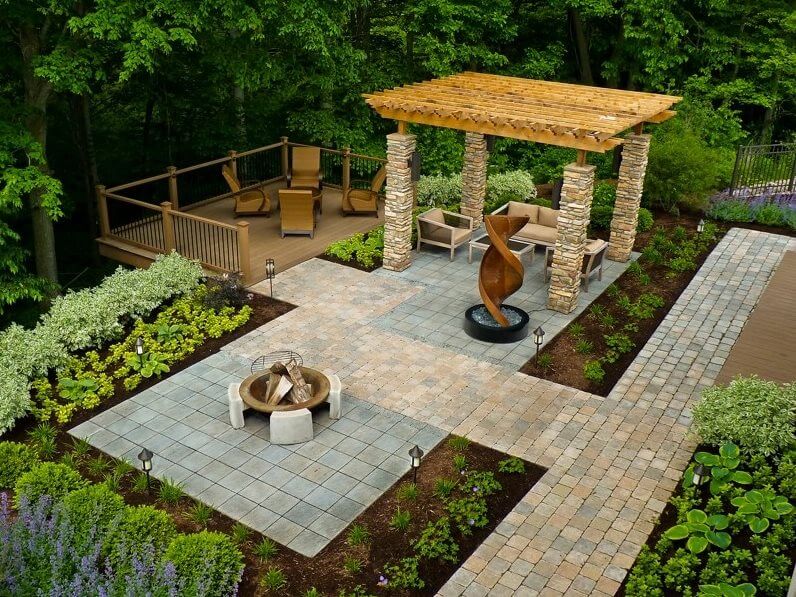The Ultimate Guide To Landscapers
The Ultimate Guide To Landscapers
Blog Article
Some Known Questions About Landscapers.
Table of ContentsLandscapers for DummiesThe Best Guide To Landscapers3 Simple Techniques For LandscapersHow Landscapers can Save You Time, Stress, and Money.The Buzz on LandscapersAll about Landscapers
- A yard attribute where water is stood for by an aggregate rock product, usually a gravel or granite.- A stone or flagstone patio, path, or walkway built without a concrete base.- A rock retaining or complimentary standing wall surface built without the use of mortar. - An underground framework that gather water and allows it to slow percolate right into the soil around it.
Landscape layout that works with a sites' setting in both appearance and sustainability without adverse impacts to the environment. Bordering in the landscape is a line of demarcation that develops visual passion in the garden by separating one sector from an additional section. This can be visual or practical, maintaining one aspect (such as pea gravel) from getting combined into another (like bark dirt).
Locations can also sense of "enclosure" given by trees, various other plantings, fences, or screens. The landscape near the entrance to a structure. A tree, hedge or vine, educated to grow on a wall or fence right into a specific pattern. Especially helpful for fruit trees, making it very easy to harvest the fruit and including mess.
How Landscapers can Save You Time, Stress, and Money.

The element in a landscape layout or location in a landscape that is indicated to be most famous. The focal point can be a plant, boulder, sculpture, collecting area, or other landscape feature.

The Basic Principles Of Landscapers
Low plants that are allowed or motivated to spread out over a location. Can refer to any kind of "tough" yard aspects consisting of statuary or rocks yet most commonly is used to refer to paths, outdoor patios, and walls - Landscapers.: Height difference between the level of water in a pond (or the level of the pump if it sits outside the pond) and the upper outlet of water which affects performance of the water pump in gph (gallons per hour).
A chemical utilized to manage weeds. Fence boards that run horizontally, commonly utilized in contemporary or Japanese-inspired landscape styles. Lines that define rooms within a landscape principle. These usually expand from edges or vital attributes of an existing framework. Appropriate use imaginary lines can help this contact form the landscape really feel attached to the home and various other aspects.
A more kicked back garden dominated by bent instead of straight bed lines and a less rigid framework. Standard PNW landscapes are informal. A plant that spreads even more than preferred, or into environments where it does damage. Portland has a checklist of invasive plants that should not be mounted in landscapes since they can spread out to forests or rivers and be tough to control.
Landscapers - The Facts
Can consist of head placements and protection, pipeline sizing, GPM specifications, and products required to mount Look At This this system. Licensed professional who creates landscapes, educated in design and style as well as in horticulture.
The expert who prepares and establishes landscape jobs, generally at a residential or small commercial level with the major design inspiration on growings. Landscape developers normally have much less education than Landscape Architects and are not certified. A finished landscape style, outlining all aspects for the new landscape. This typically takes the type of a drawing on paper.
Calcium material made use of to elevate the pH in soil, which will make it much less welcoming to moss (Landscapers). A water tight HDPE material made use of beneath ponds, streams and waterfalls in water attributes. Utilizing many growings of the exact same variety to complete a location in the landscape. This can lower upkeep and water usage in the yard.
A layer of garden compost or bark dust used at the base of a plant. A plant that was present in a geographical location that site prior to people began changing the landscape.
The Facts About Landscapers Revealed
How the garden or a yard element is arranged in relationship to an existing or new function or to a direction. Turfs that are not trimmed yet expanded in landscapes as perennials.

Plants that offer seasonal interest and after that die back in the winter. Cold period turf that is the most common lawn grass in Rose city, OR and the rest of the PNW.An open roofed framework over an outdoor patio or various other landscape function.
Basalt accumulated varying in size from 1/4" to dust. One of the most typical landscape crushed rock in the PNW. Area of the landscape made to deal with rainfall water until it can saturate into the ground. A chain that manages water as it travels from a roofing gutter to the ground. Garden framework that creates a growing area that is consisted of and higher than the bordering quality.
Structure constructed from wood, concrete, paving rocks, blocks or other materials for maintaining inclines and avoiding extreme disintegration. Narrow watercourse. Producing a yard feature consisting mostly of rocks with plantings that enhance and can thrive in the rocky atmosphere. Lawn sprinkler head design that rotates a stream of water across an area.
The Greatest Guide To Landscapers

Report this page